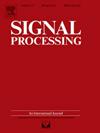Low-complexity hybrid beamforming for multi-cell mmWave massive MIMO: A primitive Kronecker decomposition approach
IF 3.4
2区 工程技术
Q2 ENGINEERING, ELECTRICAL & ELECTRONIC
引用次数: 0
Abstract
To circumvent the high path loss of mmWave propagation and reduce the hardware cost of massive multiple-input multiple-output antenna systems, full-dimensional hybrid beamforming is critical in 5G and beyond wireless communications. Concerning an uplink multi-cell system with a large-scale uniform planar antenna array, this paper designs an efficient hybrid beamformer using primitive Kronecker decomposition and dynamic factor allocation, where the analog beamformer applies to null the inter-cell interference and simultaneously enhances the desired signals. In contrast, the digital beamformer mitigates the intra-cell interference using the minimum mean square error (MMSE) criterion. Then, due to the low accuracy of phase shifters inherent in the analog beamformer, a low-complexity hybrid beamformer is developed to slow its adjustment speed. Next, an optimality analysis from a subspace perspective is performed, and a sufficient condition for optimal antenna configuration is established. Finally, simulation results demonstrate that the achievable sum rate of the proposed beamformer approaches that of the optimal pure digital MMSE scheme, yet with much lower computational complexity and hardware cost.
多小区毫米波大规模MIMO的低复杂度混合波束形成:一种原始Kronecker分解方法
为了规避毫米波传播的高路径损耗并降低大规模多输入多输出天线系统的硬件成本,全维混合波束形成在5G及以后的无线通信中至关重要。针对具有大规模均匀平面天线阵列的上行多小区系统,采用原始克罗内克分解和动态因子分配设计了一种高效的混合波束形成器,其中模拟波束形成器用于消除小区间干扰,同时增强期望信号。相比之下,数字波束形成器使用最小均方误差(MMSE)准则减轻了小区内干扰。然后,针对模拟波束形成器固有的移相器精度低的问题,开发了一种低复杂度的混合波束形成器,以减缓其调整速度。其次,从子空间角度进行了最优性分析,建立了天线最优配置的充分条件。最后,仿真结果表明,所提波束形成方案的可实现和速率接近最优纯数字MMSE方案,但计算复杂度和硬件成本大大降低。
本文章由计算机程序翻译,如有差异,请以英文原文为准。
求助全文
约1分钟内获得全文
求助全文
来源期刊

Signal Processing
工程技术-工程:电子与电气
CiteScore
9.20
自引率
9.10%
发文量
309
审稿时长
41 days
期刊介绍:
Signal Processing incorporates all aspects of the theory and practice of signal processing. It features original research work, tutorial and review articles, and accounts of practical developments. It is intended for a rapid dissemination of knowledge and experience to engineers and scientists working in the research, development or practical application of signal processing.
Subject areas covered by the journal include: Signal Theory; Stochastic Processes; Detection and Estimation; Spectral Analysis; Filtering; Signal Processing Systems; Software Developments; Image Processing; Pattern Recognition; Optical Signal Processing; Digital Signal Processing; Multi-dimensional Signal Processing; Communication Signal Processing; Biomedical Signal Processing; Geophysical and Astrophysical Signal Processing; Earth Resources Signal Processing; Acoustic and Vibration Signal Processing; Data Processing; Remote Sensing; Signal Processing Technology; Radar Signal Processing; Sonar Signal Processing; Industrial Applications; New Applications.
 求助内容:
求助内容: 应助结果提醒方式:
应助结果提醒方式:


